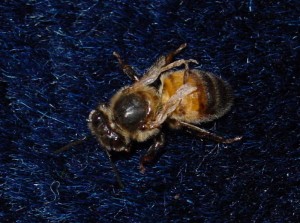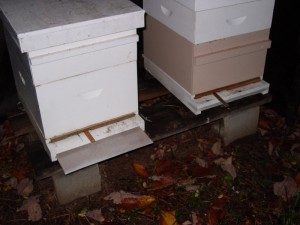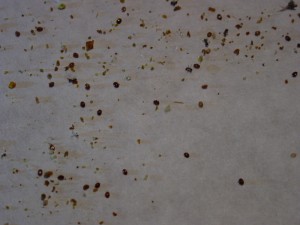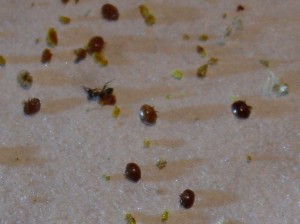Things seem to have been developing reasonably well with these hives. The top hive boxes weigh over 40 pounds, indicating the bees have laid up an adequate supply of honey for the winter. Even at the late date, some pollen continues to be brought in to the hive by foragers. But 10 days ago I saw a sign that all may not be right with these hives – this bee was slowly crawling on the landing board of hive #1:
It’s normal to have a few dead bees in front of the hive, especially at this time of the year, when drones continue to be evicted. However, most foraging bees end their careers by not returning from a final flight, and this bee is a worker, not a drone; and actually, it was still alive. It is suffering from deformed wing virus (DWV), an infection known to be transmitted by varroa mites. DWV has been implicated as one possible cause of colony collapse disorder (see here for more info: http://en.wikipedia.org/wiki/Deformed_wing_virus).
When I asked around for advice about this, opinions on what to do ranged from “just ignore it” to “burn your hives, they’re goners”. I decided to take a middle course – to determine the severity of mite infestation in the hives.
There are several ways to assess the number of mites in a bee hive. I chose the easiest and least intrusive – a mite drop survey. Each day, about 1% of the varroa mites in a colony fall to the floor of the hive (the exact number varies with the season). One simply installs a board under the hive to collect mites that drop from the colony. Fortunately, the bottom boards that I had built for these hives had been designed for this sort of monitoring, although I had never gotten around to doing it.
I made the boards from sheets of cardboard covered with freezer wrap attached by spray adhesive. It is generally recommended that the boards be covered with spray cooking oil (Pam) or petroleum jelly (Vasoline). I tried the cooking oil spray, but it didn’t seem sticky to me, so I sprayed the tops with the same adhesive (3M Super 77) that I had used to attached the paper to the cardboard. It seemed to work quite well.
Examining a sticky board is a little like sorting through a beehive’s garbage pile. There are bits of pollen, bee legs and other debris, an occasional hive beetle, as well as varroa mites. If more than a few mites are seen, then treatment should be considered. The recommended threshold varies, but more than 20 mites dropped per day in November is a sign that the hive may be headed for collapse.
(By the way, for more information about this and other topics related to varroa mites, the best Web sources of info I have found are at Scientific Beekeeping: http://www.scientificbeekeeping.com//index.php, and a United Kingdom government site: https://secure.fera.defra.gov.uk/beebase/pdfs/varroa.pdf. If you are a hobbyist beekeeper and not very familiar with the management of varroa mites, you should probably be considering some other hobby, as your hives will soon be dead.)
Here are the results of my initial mite drop survey (no data was collected from hive #1 on November 12th because an ant infestation obscured the sticky board on that day):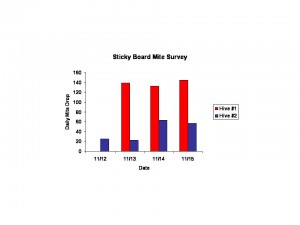
It looks like these hives (especially #1) may be in trouble.

